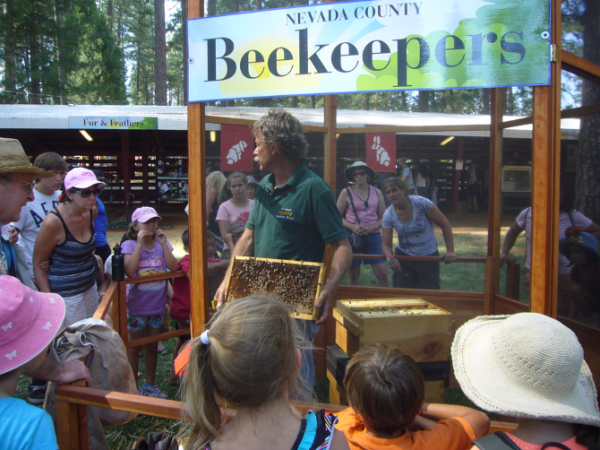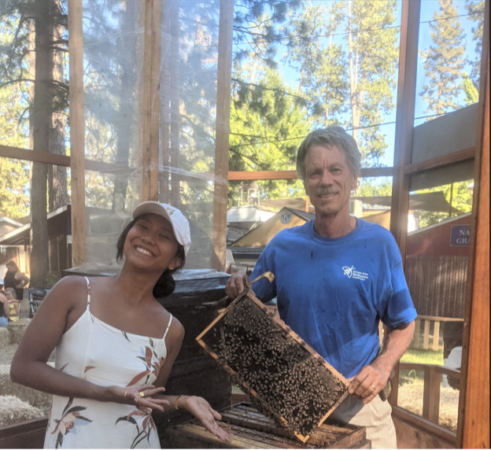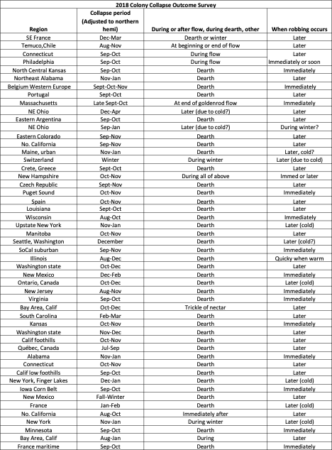A Survey on Robbing at Collapse
Robbing is Governed by Olfaction
Back to what happens upon colony collapse
A Survey on Whether Robbing Takes Place at Collapse
My Conclusions From the Survey Responses
Relationship to Bee and Mite Drift
A humorous anecdote regarding training bees to a scent
A SURVEY ON ROBBING AT COLLAPSE
Randy Oliver
ScientificBeekeeping.com
First published in ABJ February 2023
Peck and Seeley studied mite drift in an apiary in Ithaca, NY, and determined that the robbing of collapsing hives played a major role in producing surges in the mite loads of the robber colonies. But that didn’t seem to be the case where I live.
Honey bee researchers must be careful about extrapolating their field observations to other environments. The above researchers, aware that I had recently wrapped up a field study of my own, honored me by asking me to review a preprint of their paper (based upon David Peck’s doctoral dissertation). I shared my observations and data with them, and we discussed our findings at length. It became clear that although robbing during the collapse of colonies indeed occurs in the location where they made their observations, that it doesn’t necessarily happen that way in other areas.
Our discussion got me thinking about why this difference occurs. What came to the fore is just how importantly scent is involved in robbing behavior.
ROBBING IS GOVERNED BY OLFACTION
Some years ago, a friend and I built a six-sided screened enclosure for our county fair, in which we could perform a hive inspection demo each day — directly in front of viewers — with the bees coming and going freely through the open top of the enclosure, well above head level (Figure 1). This demo method has been a resounding success for presenting beekeeping to the public, since the audience can watch the presenter work bees without protective gear, while they stand inches away on the other side of the black screen.
Compared to looking through the glass of our observation hives in a nearby booth, watching a beekeeper open a hive directly in front of their faces is an entirely different experience for the viewers!

Fig. 1. In learning how to manage this display, I discovered to what degree olfaction is involved in robbing behavior. (We also have two free-flying observation hives in another booth, with the bees exiting via 1.5” pipes through the roof. The bees flying overhead do not cause any problems with the fairgoers.) Photo credit Gilles Ratia.
For our initial setup, we placed a hive in the cage a few days before the fair opened. The bees quickly learned to exit and enter through the open top of the enclosure, and there were no bees to be seen outside the cage where the viewers would be standing. All good!
When I gave my first demo, I stuck my finger into some recently-capped honey to show how we beekeepers enjoy tasting honey direct from the comb. To my surprise, within minutes a number of bees showed up on the outside of the screen directly in front of the entrance of the demo hive (which was a couple of feet back). So on subsequent demos, I was careful not to break open any cells of honey, and saw that bees didn’t suddenly show up again. So I started paying attention.
Over the years, we continued to be annoyed by small numbers of bees that would show up around the screen in front of the hive entrance. Trapping them didn’t help. It took some experimentation, but I finally figured out what was happening, and how to solve the problem.
Our Fair is held in August, when we are normally in a nectar dearth. What appeared to be happening was that the bees outside the screen were scouts from other colonies outside the fairgrounds, orienting to the odors in the air exhausting from the hive entrance inside the enclosure.
So how to move the hive entrance? It took a bit of experimentation to determine that foragers can easily circle up and down within a column of Langstroth hive bodies. This allowed me to route bee flight (and ventilation air) from the demo hive through a stacked column of empty supers going up to the top of the cage (10 feet off the ground). Problem solved — no more curious bees on the screen! It was clearly the odor of the hive exhaust that had been attracting them.
We continue to experiment, and last summer replaced the upper boxes with a chase of clear plastic, so the audience can watch the bees fly up and down (Figure 2).

Fig. 2. My helper Rose Pasetes (dressed for enjoying the fair with her husband) dropped in to join me for this demo. You can see the clear plastic flight column behind her head.
I’m well aware of how incredibly sensitive honey bees are to odor, and how easily they can be trained to associate an odor with a sugar reward (in the field, such as how Jerry Bromenshenk trained bees to locate land mines, or in the lab via the “proboscis extension response” (PER) [[1]]). So after observing the screen-thwarted robbing pressure on our demo hive, I’ve paid close attention to robbing behavior in our apiaries and around our honey house. I’ve noticed a number of things:
- We can have stacks of unused brood chambers containing honey sitting on pallets in the yard, and bees may not pay any attention to them for weeks or months, unless we break open the honey.
- When we’re extracting honey, the vent of the extracting room will be mobbed by bees if we’re extracting a honey that was recently gathered, but otherwise there is far less interest.
- Ditto in our storage yard: if a scout happens to come across some exposed honey, they will quickly return with recruits — and seek out any other honey of the same floral variety stored in the yard.
- When removing honey supers, robbing is far more intense if there is still ripening nectar in the hives than it is if we wait until that specific nectar source has not been being gathered for a while. Potential robbers appear to cue in on the specific odor of ripening nectar from whatever flower species they are currently or had recently been working.
- Our nucleus colonies can get the heck robbed out of them while there’s a strong nectar flow going on.We’ve seen this happen to an entire yard of nucs – leaving them cleaned out of honey by the end of a strong springtime flow, after watching heavy robbing clearly taking place during morning foraging with little or no fighting at the entrances. The foragers of the nucs appeared to just continue with normal foraging, while robbers from somewhere else went in an out without interference.
- When we have a nectar flow on, robbers quickly descend upon combs of ripening nectar if we pull them from hives.But at the same time in the same yard, where we have returned hive bodies containing plenty of combs with patches of sealed honey, stacked wide open for robbing, the abundant bees show no interest.
It’s pretty clear that scouts and foragers are exquisitely sensitive to (and cue into) specific scents with which they’ve learned to associate with a sweet reward. On the other hand, they may ignore the scent of exposed honey to which they have not yet associated with a reward.
Practical application: All one need to do to demonstrate how closely tied odor is to robbing, is to feed sugar syrup with added scent to a group of colonies during a dearth.
BACK TO WHAT HAPPENS UPON COLONY COLLAPSE
Where Peck and Seeley ran their study there is a mid-September nectar flow in Ithaca, NY) [[2]], with a distinctive goldenrod odor. Since their mite-donor colonies collapsed in late-September, they would likely have been emitting the odor of ripening goldenrod nectar. That would have made them very attractive to scout bees from other hives searching for any source of that odor (since the bloom would have been tapering off, and the scouts and foragers would have already been trained to associate that specific scent with a sweet reward). Thus we would expect immediate robbing pressure on any collapsing colonies to take place.
On the other hand, where I live, the typical observation is that “my colony was strong in August, and then the bees suddenly disappeared, leaving a hive full of honey, but without any bees.” I’ve seen it plenty of times myself, and heard it over and over again from those coming to purchase replacement nucs the next year.
Practical application: Our collapsing hives don’t contain any ripening nectar, so even a handful of bees are able to defend them. And even after those last bees are gone, the deadout often sits for days or weeks before it eventually gets robbed. If the bees are all gone by the time robbing takes place, then there wouldn’t be any live mites left to transfer onto the robbers (any mites still in remaining sealed brood would be unable to escape through the cappings.).
So the question to me was, does such lack of robbing during collapse occur elsewhere. So I asked some other beekeepers around the world.
A SURVEY ON WHETHER ROBBING TAKES PLACE AT COLLAPSE
I put out a request to members of the Bee-L discussion group to fill out a survey. I asked them the following questions:
- Your region? (state, country, province, etc).
- The typical period of varroa/DWV collapses in your region? (month – month).
- Do varroa/DWV collapses in your area typically occur during or immediately after a nectar flow, or during a dearth? (during flow, immediately after, dearth)
- Do the collapsed hives get robbed out immediately or later? (immediately or later).
Fifty-one beekeepers responded; their answers are in Table 1 (names redacted).
Table 1. Survey on observations of colony collapse and robbing. Note how many respondents stated that robbing occurs later, rather than during collapse.

I noticed that Dr. Peck’s published paper [[3]] included the following:
Because it has been observed that bees in some locations do not readily rob weak colonies in the autumn (Randy Oliver, pers. comm.), it is entirely possible that the robbing-driven “mite bomb” phenomenon that we observed in New York state may differ from the “mite bomb” phenomenon in other places, where drifting may play a larger role, or robbing a smaller one.
MY CONCLUSIONS FROM THE SURVEY RESPONSES
Robbing of collapsing (as opposed to collapsed) hives can clearly result in mite transfer from the hive being robbed to the robbing hive, but only in those areas in which robbing occurs at the time of collapse.
- Colonies kept in areas with long winters collapse later in the season—likely because varroa buildup starts later.These colonies often collapse when the weather is below flight temperature, so no robbing or mite drift can take place.
- In Mediterranean climates with summer dearths, collapse appears to seldom be associated with robbing.I suspect that this is due to scouts or robbers in the neighborhood not associating the slight scent of the well-cured honey in those collapsing hives with a reward.
- An exception to the above is where Africanized bees are established, such as in the southern U.S. (including Southern California) where the robbing pressure by AHB can be intense.
- On the other hand, in areas where there is a nectar flow occurring or tapering off during the collapse of a colony, those hives can face immediate exploitation by robbers during their process of collapse. I suspect that this is due to scouts, foragers, and robbers in the neighborhood having learned to associate the scent of that ripening nectar with a reward.
RELATIONSHIP TO BEE AND MITE DRIFT
So in Mediterranean regions, there may not be much mite immigration due to rob outs of collapsing colonies. But that still leaves the question of what happens to all the bees and mites in those collapsing hives? (They may vanish, but not into thin air). Other studies indicate that they don’t appear to show up in nearby colonies to any great extent. Follow the results of my field trial with tagged bees to see what occurred at my neighborhood.
A HUMOROUS ANECDOTE REGARDING TRAINING BEES TO A SCENT
Years ago I pulled into an outyard during our August dearth, and noticed a scrawled handwritten note on top of a hive. A neighbor had written that he had been attacked in his driveway by our bees!
Incredulous, I drove over to see what happened. He sheepishly apologized, since he had since realized that he hadn’t actually been attacked. Then he explained what had happened.
He told me that he was a Dr. Pepper “junkie,” drinking a few cans a day, and threw the empty cans into a recycling can in his garage. On the day of the “event” he had accidentally left the door open, and returned to a garage full of hungry bees scavenging the remaining sugary residues in the cans.
Come dusk, after the bees had gone home, he closed the garage door.
By noon of the next day there were no more bees to be seen around the garage. Proud of his victory, while standing in the driveway he opened a can of Dr. Pepper to celebrate. Unnoticed foragers still searching for the scent of the previous day’s prize immediately descended upon the can in his hand. Luckily he didn’t do anything foolish that might have led to a sting.
I commended him for having trained the bees to the scent of Dr. Pepper, gave him a case of honey, and all was well.
ACKNOWLEDGEMENTS
I want to honor my late friend Tim Madeira, with whom I built our demo cage, shortly before he unexpectedly passed away. Appreciation to Drs. David Peck and Tom Seeley. And thanks to those who filled out my survey. Dr. Peppers all around!
CITATIONS AND NOTES
[1] Smith, B & C Burden (2014). A proboscis extension response protocol for investigating behavioral plasticity in insects: application to basic, biomedical, and agricultural research. Journal of Visualized Experiments (91): e51057.
[2] Seeley, TD (1995) The Wisdom of the Hive, p. 44.
[3] Peck DT & TD Seeley (2019) Mite bombs or robber lures? The roles of drifting and robbing in Varroa destructortransmission from collapsing honey bee colonies to their neighbors. PLoS ONE 14(6): e0218392.



